飛行課程 Stage 1 - Aerodynamics of Maneuvering Flights
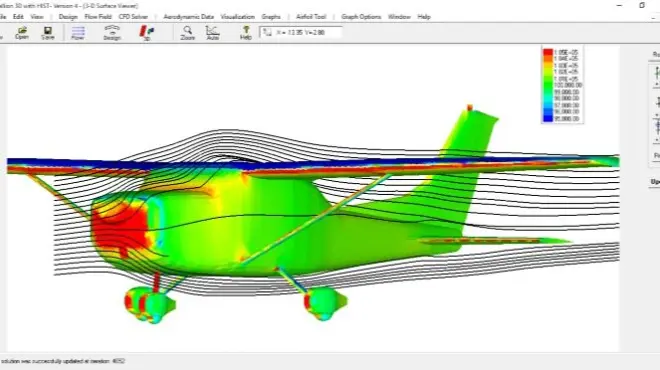
Content:
Climbing Flight
Left-Turning Tendencies
Descending Flight
Turning Flight
Load Factor

1. Climbing Flight
Transitioning into climb requests:
An increase in the pitch attitude
An increase in power (The thrust required to sustain a given airspeed for cruising flight is not enough to maintain the same airspeed in a climb)
2. Left-Turning Tendencies
Four factors that cause left-turning tendencies in a propeller-driven aircraft:
Torque
The clockwise rotation of a spinning propeller causes a reaction force, called torque, which tends to roll the airplane left about its longitudinal axis
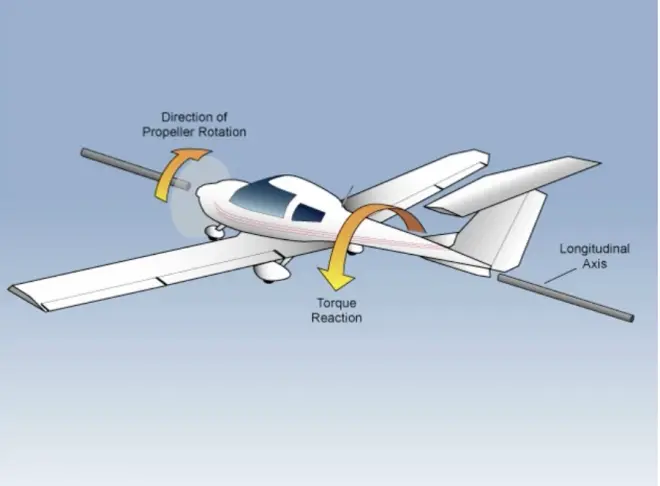
Gyroscopic precession
Downward pitch applies a force to the top of the propeller; gyroscopic precession causes the airplane to yaw to the left
Upward pitch applies a force to the bottom of the propeller; gyroscopic precession causes the airplane to yaw to the right
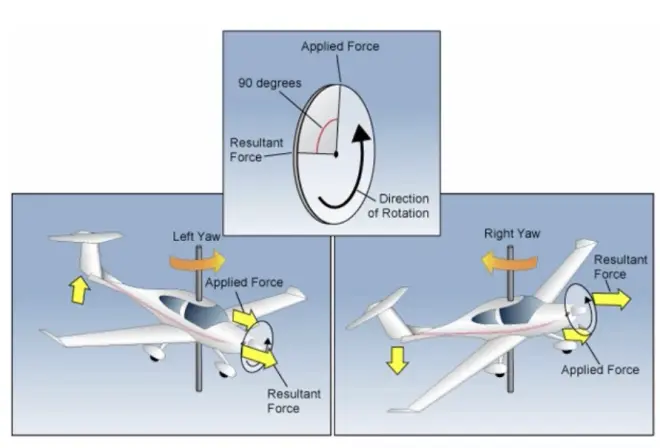
Asymmetrical thrust of the propeller (P-factor)
occurs when you fly an airplane at a high angle of attack, such as during takeoff or a climb
Flying the airplane at a high angle of attack causes uneven angles of attack between the ascending and descending propeller blades, which causes the airplane to yaw to the left
P-factor is most pronounced when the engine is operating at a high power setting, and when the airplane is flying at a high angle of attack
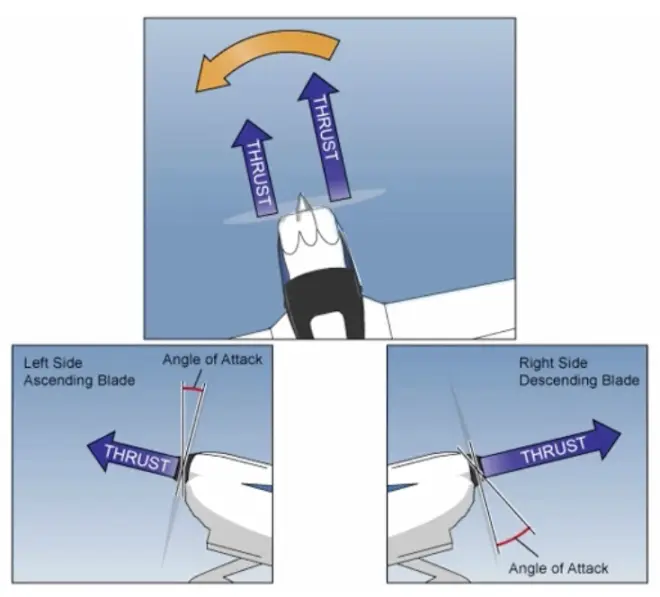
Spiraling slipstream
As the propeller rotates, it produces a backward flow of air, or slipstream, which wraps around the airplane
The spiral slipstream strikes the left side of the vertical tail, and the resulting force causes the airplane to yaw about its vertical axis, moving the nose to the left
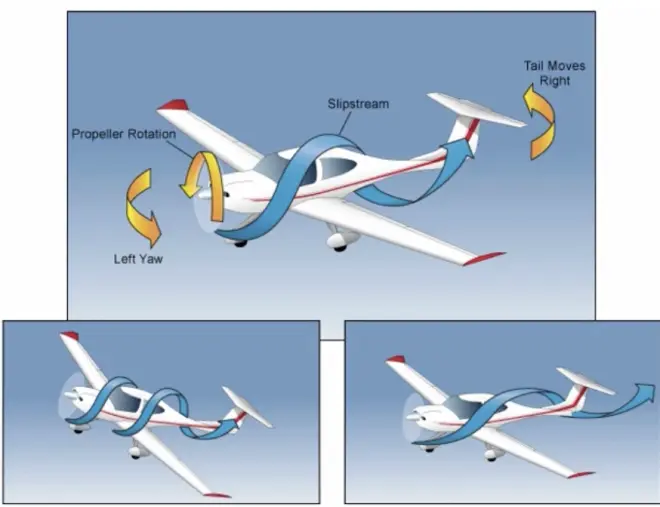

3. Descending Flight
How weight affects airspeed: in stablized descending light, aerodynamic forces are in equilibrium with the force of weight, which consists of two components:
Weight that acts perpendicular to the flight path
Weight that acts forward along the flight path
In a power-on descent, the forward component of weight increases, which increases airspeed without increasing thrust; the increase in airspeed also increases parasite drag, which balances the forward component of weight
In a power-off descent, lowering the nose increases the forward component of weight, which counteracts drag and enables the aircraft to clide at a constant airspeed
Lift-to-Drag Ratio (L/D)
Determines gliding efficiency
Provides:
The maximum gliding distance
The best glide angle for descent
Best Glide Speed
Critical after an engine failure
Deviation from best glide speed will increase drag and reduce the distance you can glide
Glide ratio is not affected by weight variations
Airplanes will travel the same distance regardless of weight if the best glide speed for the actual weight is maintained
Confiurations Affects a Glide:
Any change in aircraft configuration that increases drag reduces glide efficiency
Lowering flaps and landing gear increases both parasite drag and total drag, which reduces the airplane's maximum lift-to-drag ratio and glide ratio
To maintain airspeed with landing gear extended, lower the nose of airplane
'
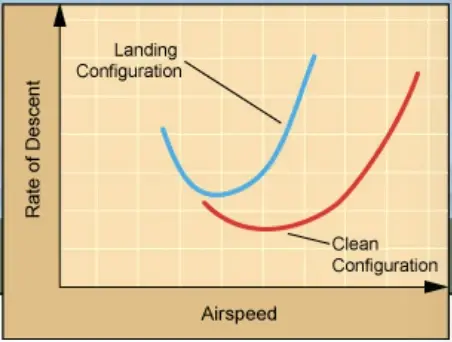
Wind Affects a Glide
Headwinds
Reduce glide distance
In a strong headwind, increase glide speed to optimize the distance you can travel for a given altitude
Tailwinds
Increase glide distance
Decrease the normal best glide speed to take advantage of strong tailwinds
Look in your aircraft POH for recommended adjustments to best glide speed during strong headwinds or tailwinds

4. Turning Flights
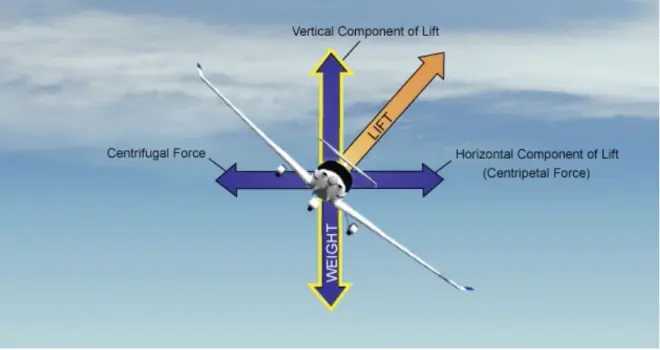
Forces Involved in a Turn:
Centripetal force is the horizontal component of lift that causes the airplane to turn
Centrifugal force is the apparent force that results from inertial resistance to a turn
To maintain altitude during a turn, you must increase lift until the vertical component of lift equals weight
Cordinated Turns
When centrifugal force euqals the horizontal component of the lift
Am imbalance of turning forces causes uncoordinated flight conditions such as slips or skids
Slip: Occurs when centrifugal force is less than the horizontal component of lift
Pilot feels a sideways force to the inside of turn
Decrease the amount of bank?
Increase the rate of turn by applying more rudder pressure in the direction of the turn
Skids: Occurs when centrifugal force exceeds the horizontal component of lift
Pilot feels a sideways force to the outside of a turn
Increase the amount of bank
Decrease the rate of turn by applying less rudder pressure in the direction of the turn?
Correcting Uncoordinated Turns (Adverse Yaw)
Occurs during a turn when the outside wing produces more lift and induced drag than the inside wing
Yawing tendency occurs opposite the direction of the turn
To correct this, coordinate the use of aileron and rudder to compensate for the adverse yaw
Correcting Uncoordinated Turns (Overbanking Tendency)
Occurs by additional lift on the outside wing after increasing the angle of bank
The outside wing travels faster than the inside wing, producing more lift, causing excess roll
To correct for overbanking tendency, use a small amount of opposite aileron to maintain the desired angle of bank
Rate, Radius, Bank Angle, and Airspeed
Rate: Amount of time necessary for an airplane to turn a specified number of degrees
Radius: Amount of horizontal distance an aircraft uses to complete a turn
Bank Angle:?
Affects both the rate and radius of a turn
Increased angle of bank at a constant airspeed decreases the turn radius and increases the rate of turn (takes less time to complete a turn)
Decreased angle of bank at a constant airspeed increases the turn radius and decreases the rate of turn (takes more time to complete a turn)
Airspeed:
Affects both the rate and radius of a turn
Increased airspeed at a constant angle of bank decreases the rate of turn and increases the radius
Decreased airspeed at a constant angle of bank increases?the rate of turn and decreases the radius

5. Load Factor
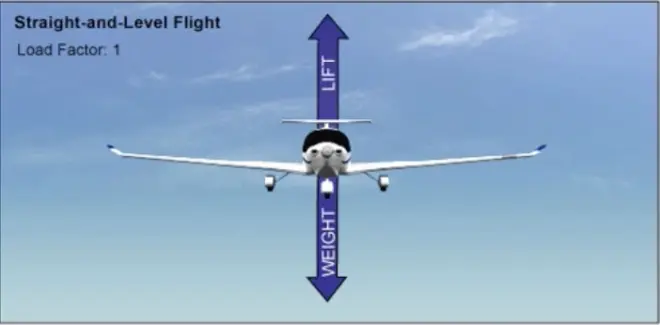
Load Factor: the ratio of the weight supported by the airplane's wings to the actual weight of the aircraft and its contents
Load Factor is measured in terms of G-forces (Gs)
Turning or banking the airplane while maintaining a constant altitude increases the load factor
Load factor changes during flight due to pilot input or environmental conditioins
Angle of Bank Affects Load Factors:
Load factor is proportional to angle of bank
At 45 degrees angle of bank, load factor is 1.4 Gs
At 60 degrees angle of bank, load factor is 2 Gs
During constant altitude turns, the relationship between load factor and angle of bank is the same for all airplanes, regardless of speed or size
The vertical component of lift decreases in a turn, causing altitude loss until you increase the thrust to maintain airspeed and increase the angle of attack by increasing the back-pressure on the control stick
Load Factor Affects Stall Speed:
Load factor and stall speed are directly proportional
An airplane that has a 1G stalling speed of 70 knots, when rolled into a 60 degree bank, will stall at 98 knots at 2Gs (40% increase)
At 75 degrees angle of bank, the load factor increases to 4Gs and there is a 100 percent increases in stall speed
Limit Load Factor: The amount of stress, or load factor, that an airplane can withstand before structural damage occurs.?
The POH specifies the limit load factor, expressed as maximum positive and negative Gs
Adhere to proper loading techniques and fly within the limits listed in the POH to help void structural damage
The Envelope: The V-g diagram depicts the envelope of an airplane's velocity (V) and load factor (G)
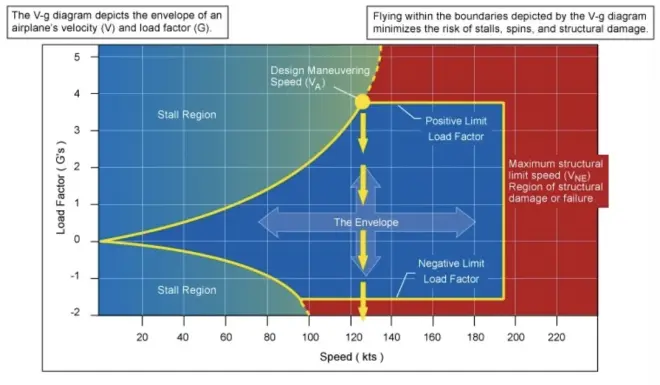
Maneuvering Speed and Structural Limits
Design maneuvering speed (V_A) is the maximum speed at which you can use full, abrupt flight control movement without overstressing the airframe
Operating at or below maneuvering speed causes the airplane to stall before you exceed the limit load factor, which prevents damage to the airplane
At airspeeds higher than maneuvering speed, excess load can cause structural damage before a stall occurs
Maneuvering Speed is directly?proportional to the weight

